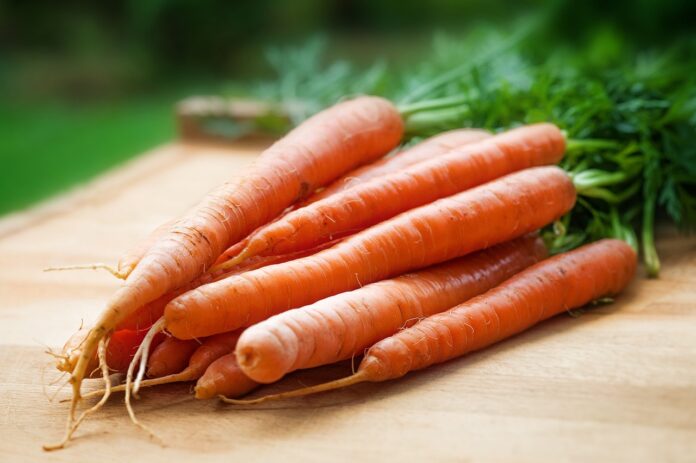Carrots (Daucus carota) are root vegetables that have been cultivated and enjoyed for centuries, originating in the region now known as Afghanistan around 900 AD. Known for their vibrant colors—ranging from the familiar orange to purple, yellow, red, and white—carrots are prized not only for their sweet, earthy taste but also for their nutritional benefits. Rich in beta-carotene, fiber, vitamins (notably vitamin A), and antioxidants, carrots support vision health, immune function, and overall wellness.
Interesting Facts About Carrot:
- Carrot History: Carrots were first cultivated in Afghanistan around 900 AD and were initially purple, white, and yellow. The familiar orange variety we know today was developed in the Netherlands in the 17th century
- Health Benefits: Known for being rich in beta-carotene, carrots contribute significantly to vision health. This compound is converted to vitamin A, which is essential for maintaining eyesight, particularly in low-light conditions. Carrots also contain antioxidants like lutein, which help protect the eyes from blue light damage
- Record-Breaking Carrots: The heaviest carrot on record weighed almost 19 pounds, and the longest one reached over 20 feet. These extraordinary specimens were grown in the UK, highlighting the potential of this vegetable to reach impressive sizes
- Carrots and WWII: During WWII, British pilots were encouraged to eat carrots to improve night vision, a campaign that eventually contributed to the myth that carrots can enable people to see in the dark
- Global Uses of Carrots: Carrots are enjoyed in various ways around the world. In Japan, they’re used in pickled dishes and tempura, while in Morocco, they are often cooked with spices as a flavorful side dish. In India, carrots are a key ingredient in gajar ka halwa, a sweet dessert
- Growing Popularity: Carrots thrive in well-drained soil and full sunlight and can be grown in containers, making them a great crop for urban gardeners. They typically take 70-80 days to mature from seed to harvest
- Symbol in Popular Culture: Carrots are a popular food for cartoon characters like Bugs Bunny, and they also feature prominently in the movie “Peter Rabbit.” This association has cemented carrots as a fun, iconic vegetable in pop culture
- Variety of Colors: There are over 100 varieties of carrots worldwide, with colors that range from orange to purple, red, yellow, and white. Each color variant provides unique nutrients, with purple carrots, for example, being particularly high in antioxidants
- Carrot Top Greens: The leafy greens on top of carrots, often discarded, are actually edible and can be used in salads, soups, or even pesto
- Versatile Snack and Ingredient: In the U.S., carrots are popular as a snack, often eaten raw with dips or added to salads. They’re also a key ingredient in many baby foods and a variety of dishes worldwide, adding nutrition and a mild, sweet flavor
- Carrots are celebrated for their high beta-carotene content, which the body converts to vitamin A—an essential nutrient for eye health and good vision. During World War II, British pilots were even encouraged to eat carrots to improve their night vision, sparking a myth that carrots could help people see in the dark
- Baby carrots aren’t a separate variety; they’re simply standard carrots cut and shaped to be smaller. These small, convenient carrots have become especially popular as snacks
- There are over 100 different carrot varieties worldwide, with colors ranging from purple to red, yellow, and white. Each color contains different antioxidants, adding unique health benefits and flavors
- Carrots are low in calories but high in fiber, vitamin C, potassium, and vitamin K, making them a nutritious snack that supports immunity, bone health, and digestive health
- The world’s longest carrot was recorded in the UK, reaching over 20 feet, while the heaviest carrot ever grown weighed nearly 19 pounds. These records highlight the impressive potential for growth in this humble vegetable
- Carrot tops, often discarded, are actually edible. They can be used in salads, soups, and even pesto, adding a slightly bitter, earthy flavor to dishes
- Carrot juice is a popular way to enjoy this vegetable’s health benefits and is commonly consumed for its sweet taste and high nutrient content
- Carrots were traditionally grown for their leaves and seeds rather than their roots, which only became a primary food source through selective breeding over centuries
- China, Russia, the United States, and Uzbekistan are the top carrot-producing countries, reflecting carrots’ global appeal and versatility
